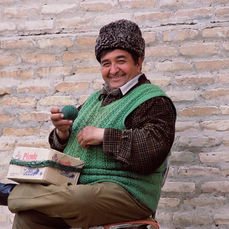
Uzbekistan, Oriental Land of Mystery
Text & Photography by Eric Pasquier
The most historically fascinating republic in Central Asia, Uzbekistan is a mysterious landlocked country of desert and grassland. Despite repeated invasion by the world's fiercest conquerors, it is still home to some of Islam’s greatest architectural wonders.
Uzbekistan’s geographical position made it the epicentre of regional trade for millennia, and of enormous strategic importance. Waves of invaders and traders have come and gone, from Persians to Mongols and Huns. Some passed through, while others settled. But all left their mark. Alexander the Great founded eight cities here and married the daughter of a local chieftain.
Caravans began travelling the fabled Silk Road in the 2nd Century BC when China opened its borders. They brought Buddhism and contact with the wider world. In the 6th Century AD, the Turks introduced Islam, and the area prospered.
Genghis Khan invaded in 1220, decimating the country and destroying Bukhara and Samarkand. His descendant Timur - also known as Tamerlane - rebuilt the country using slave labour. Uzbeks regard Tamerlane as the “father of the nation”, despite the fact he was a bloodthirsty tyrant who burned libraries and built towers with the skulls of defeated armies.
The region again rose to prosperity, and Samarkand became a glittering Islamic capital. Recounting his time there in the 13th Century, Marco Polo told of “a noble city, adorned with beautiful gardens, and surrounded by a plain, in which are produced all the fruits that man can desire.”
Russia gained control in 1875 and, following the Bolshevik revolution, the Soviet republic of Uzbekistan was declared in 1924. It became independent in 1991, but although the Communist Party changed its name, it is still in power.
The legacy of Uzbekistan’s past is visible in its cities and the people who live there. Few places evoke exotic imagery like Samarkand, once dubbed the “Pearl of the Islamic World". Time has done little to change this, and the old centre retains an air of majesty, with intricate ornamentation, fine mosaics, and blue-tiled domes and façades.
Equally fascinating is Bukhara, also a commercial centre on the Silk Road - its 12th Century Kalan Minaret was once the tallest building in Asia. Another former trading post, Khiva’s historic heart is preserved as an open-air museum, containing mosques and palaces decorated with turquoise tiles. Its narrow streets and clay-walled houses give an impression of life in medieval Central Asia.
Tashkent is the national capital, but its own history fell victim to Soviet city planning and a devastating earthquake in 1966. Today it is an ugly parade of concrete apartment blocks, though some remnants of the old town survive.
On market days, Uzbekistan’s bustling bazaars become a melting pot of traders. Many Uzbek men wear traditionally quilted coats and a ‘dopy’ – a four-sided black cap with white trim.
Women often wear braids signifying marital status – more braids means more single.
The biggest national festival is ‘Navrus’, held each March to celebrate the arrival of spring. This two-day party consists of fairs, music, arts, and sports – including ‘buzkashi’: a form of no-rules polo featuring a dead goat. A referee throws a carcass into the arena, and chaos descends as horsemen fight to grab it. The winner is whoever throws the goat over the finishing line. Huge crowds always assemble to watch the mayhem.
Sadly, the environmental scars of Communist mismanagement are plain to see. Irrigation of cotton fields severely depleted the Aral Sea - now half the size it once was - poisoning the region’s soil and wreaking havoc with the weather.
Nowhere is this more obvious than in Moynaq: once a major fishing port, its fleet lies rusting on the sand, 40 km from the sea.
But like Genghis Khan and Alexander the Great, the Soviets failed to quell the spirit of the Uzbeks, and their proud land remains an unmissable stop on a tour of Asia’s finest heritage.























